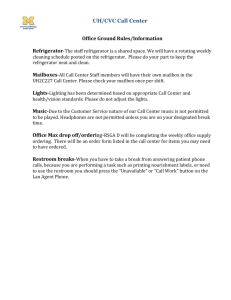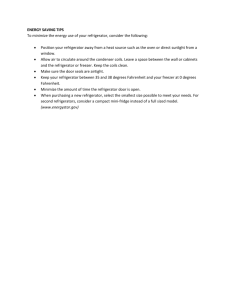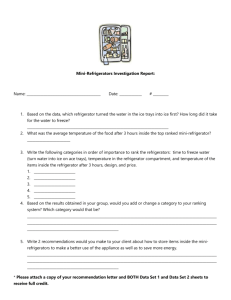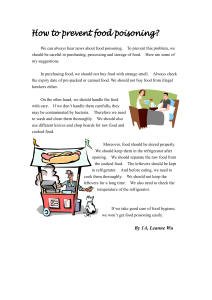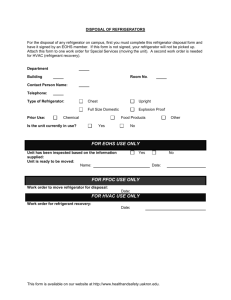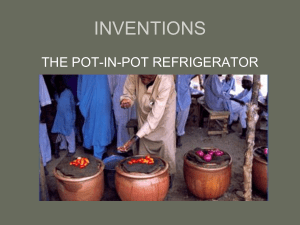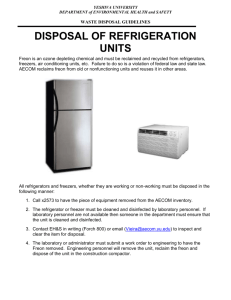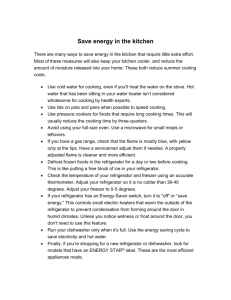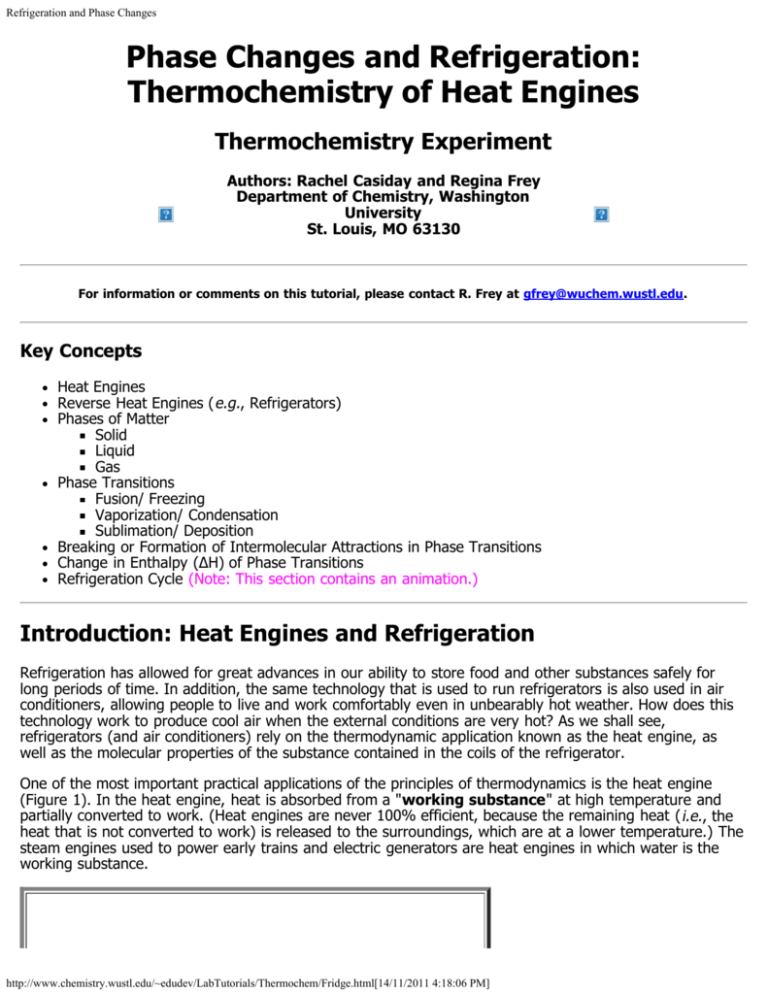
Refrigeration and Phase Changes
Phase Changes and Refrigeration:
Thermochemistry of Heat Engines
Thermochemistry Experiment
Authors: Rachel Casiday and Regina Frey
Department of Chemistry, Washington
University
St. Louis, MO 63130
For information or comments on this tutorial, please contact R. Frey at gfrey@wuchem.wustl.edu.
Key Concepts
Heat Engines
Reverse Heat Engines ( e.g., Refrigerators)
Phases of Matter
Solid
Liquid
Gas
Phase Transitions
Fusion/ Freezing
Vaporization/ Condensation
Sublimation/ Deposition
Breaking or Formation of Intermolecular Attractions in Phase Transitions
Change in Enthalpy (ΔH) of Phase Transitions
Refrigeration Cycle (Note: This section contains an animation.)
Introduction: Heat Engines and Refrigeration
Refrigeration has allowed for great advances in our ability to store food and other substances safely for
long periods of time. In addition, the same technology that is used to run refrigerators is also used in air
conditioners, allowing people to live and work comfortably even in unbearably hot weather. How does this
technology work to produce cool air when the external conditions are very hot? As we shall see,
refrigerators (and air conditioners) rely on the thermodynamic application known as the heat engine, as
well as the molecular properties of the substance contained in the coils of the refrigerator.
One of the most important practical applications of the principles of thermodynamics is the heat engine
(Figure 1). In the heat engine, heat is absorbed from a "working substance" at high temperature and
partially converted to work. (Heat engines are never 100% efficient, because the remaining heat ( i.e., the
heat that is not converted to work) is released to the surroundings, which are at a lower temperature.) The
steam engines used to power early trains and electric generators are heat engines in which water is the
working substance.
http://www.chemistry.wustl.edu/~edudev/LabTutorials/Thermochem/Fridge.html[14/11/2011 4:18:06 PM]
Refrigeration and Phase Changes
Figure 1
In a heat engine, an input of heat causes an increase in the
temperature of the working substance, allowing the working
substance to perform work. In this schematic diagram, the
working substance is water. At high temperature, gaseous water
(steam) pushes a piston, which causes a wheel to turn. This is the
essential mechanism by which steam-powered trains operate.
In a reverse heat engine (Figure 2), the opposite effect occurs. Work is converted to heat, which is
released.
Figure 2
In a reverse heat engine, a work input is converted to a heat
output. In this case, the work (generated by electricity) condenses
gaseous water (steam) and pushes it into a heat-exchange coil. In
the coil, the temperature of the water drops as it liquefies,
releasing heat to the environment.
In 1851, the Florida physician John Gorrie was granted the first U.S. Patent for a refrigeration machine,
which uses a reverse heat engine (Figure 2) as the first step in its operation. Gorrie, convinced that the
cure for malaria was cold (because outbreaks were terminated in the winter), sought to develop a machine
that could make ice and cool a patient's room in the hot Florida summer. In Dr. Gorrie's refrigerator, air
http://www.chemistry.wustl.edu/~edudev/LabTutorials/Thermochem/Fridge.html[14/11/2011 4:18:06 PM]
Refrigeration and Phase Changes
was compressed using a pump, which caused the temperature of the air to increase (exchanging work for
heat). Running this compressed air through pipes in a cold-water bath released the heat into the water.
The air was then allowed to expand again to atmospheric pressure, but because it had lost heat to the
water, the temperature of the air was lower than before and could be used to cool the room.
Modern refrigerators operate by the same reverse-heat-engine principle. Whereas a heat
engine converts heat (from a high-temperature area) to work, a refrigerator converts work to
heat. Modern refrigerators use substances other than air as the coolant; the coolant substance
changes from gas to liquid as it goes from higher to lower temperature. This change from gas
to liquid is a phase transition, and the energy released upon this transition is mainly
dependent on the intermolecular interactions of the substance. Hence, to understand the
refrigeration cycle used in modern refrigerators, it is necessary to first discuss phase transitions.
Questions on Heat Engines and Refrigeration
In many homes and businesses, heat pumps are replacing conventional heaters to heat buildings by
using electricity to transfer heat to the inside of the building.
a. Is the heat pump an example of a heat engine or a reverse heat engine? Briefly, explain
your reasoning.
b. Briefly, describe the process by which the heat pump transfers heat into a building.
What was the "working substance" in Dr. Gorrie's refrigerator?
Phases and Phase Transitions
Matter can exist in three different phases (physical states): solid, liquid, and gas. A phase is a form of
matter that is uniform throughout in chemical composition and physical properties, and that can be
distinguished from other phases with which it may be in contact by these definite properties and
composition. As shown in Figure 3, a substance in the solid phase has a definite shape and rigidity; a
substance in the liquid phase has no definite shape, but has a definite volume, and a substance in the gas
phase has no definite shape or volume, but has a shape and volume determined by the shape and size of
the container.
http://www.chemistry.wustl.edu/~edudev/LabTutorials/Thermochem/Fridge.html[14/11/2011 4:18:06 PM]
Refrigeration and Phase Changes
Figure 3
This schematic diagram shows the differences in physical
properties and particle arrangement between a substance in the
solid, liquid, and gas phases. In a solid, the particles are densely
packed in a rigid configuration, giving the substance a definite
shape and size. In a liquid, the particles are close together but
may move with respect to one another, giving the substance a
definite volume but a fluid shape. In a gas, the particles may
occupy the entire volume of the container, so that their shape and
volume are both defined by the container.
Molecular (Microscopic) View
One of the major differences in the three phases illustrated in Figure 3 is the number of intermolecular
interactions they contain. The particles in a solid interact with all of their nearest neighbors (recall the
discussion of bonding in solids from the tutorial entitled "Bands, Bonds, and Doping: How Do LED's
Wrok?"), the particles in a liquid interact with only some of the nearby particles, and the particles in a gas
ideally have no interaction with one another. By breaking or forming intermolecular interactions, a
substance can change from one phase to another. For example, gas molecules condense to form liquids
because of the presence of attractive intermolecular forces. The stronger the attractive forces, the greater
the stability of the liquid (which leads to a higher boiling point temperature). A transition between the
phases of matter is called a phase transition. The names of the phase transitions between solid, liquid, and
gas are shown in Figure 4.
Figure 4
This diagram shows the names of the phase transitions
http://www.chemistry.wustl.edu/~edudev/LabTutorials/Thermochem/Fridge.html[14/11/2011 4:18:06 PM]
Refrigeration and Phase Changes
between solids, liquids, and gases. The arrow to the right of
the diagram demonstrates that these three phases have
different enthalpies: gas has the highest enthalpy, liquid has
an intermediate enthalpy, and solid has the lowest enthalpy.
Hence, each of the phase transitions shown in this figure
involves a change in the enthalpy of the substance.
Phase transitions are a type of chemical reaction. Most of the chemical reactions studied in Chem 151 and
152 involve the breaking or forming of bonds within molecules; phase transitions involve the breaking or
forming of intermolecular forces (attractive interactions between molecules). Hence, as with other chemical
reactions, it is necessary to discuss the energy that is absorbed or given off during the breaking or forming
of intermolecular interactions in a phase transition.
Phase transitions involving the breaking of intermolecular attractions ( i.e., fusion (melting),
vaporization, and sublimation) require an input of energy to overcome the attractive forces
between the particles of the substance. Phase transitions involving the formation of
intermolecular attractions ( i.e., freezing, condensation, and deposition) release energy as the
particles adopt a lower-energy conformation. The strength of the intermolecular attractions between
molecules, and therefore the amount of energy required to overcome these attractive forces (as well as the
amount of energy released when the attractions are formed) depends on the molecular properties of the
substance. Generally, the more polar a molecule is, the stronger the attractive forces between
molecules are. Hence, more polar molecules typically require more energy to overcome the intermolecular
attractions in an endothermic phase transition, and release more energy by forming intermolecular
attractions during an exothermic phase transition.
Thermodynamic (Macroscopic) View
In addition to the microscopic, molecular view presented above, we can describe phase transitions in terms
of macroscopic, thermodynamic properties. It is important to bear in mind that the microscopic and
macroscopic views are interdependent; i.e., the thermodynamic properties, such as enthalpy and
temperature, of a substance are dependent on the molecular behavior of the substance.
Phase transitions are accompanied by changes in enthalpy and entropy. In this tutorial, we will concern
ourselves mainly with changes in enthaply. The energy change involved in breaking or forming
intermolecular attractions is primarily supplied or released in the form of heat. Adding heat causes
intermolecular attractions to be broken. How does this occur? Heat is a transfer of energy to
molecules, causing the molecules to increase their motion as described by the kinetic theory of gases
(discussed in the tutorial entitled, "Gas Laws Save Lives: The Chemistry Behind Airbags"), and thereby
weakening the intermolecular forces holding the molecules in place. Likewise, molecules lose heat to
form intermolecular attractions; when heat is lost, the molecules move slower and therefore can
interact more with other nearby molecules.
Because phase changes generally occur at constant pressure ( i.e., in a reaction vessel open to the
atmosphere), the heat can be described by a change in enthalpy (ΔH=q p =nC p ΔT, where n is the number
of moles of the substance and Cp is the molar heat capacity at constant pressure). For phase transitions
involving the breaking of intermolecular attractions, heat is added and ΔH is positive, because
the system is going from a lower-enthalpy phase to a higher-enthalpy phase, as shown by the
direction of the vertical arrow to the right of Figure 4. Hence, fusion, vaporization, and sublimation are all
endothermic phase transitions. For phase transitions involving the forming of intermolecular
attractions, heat is released and ΔH is negative, because the system is going from a higherenthalpy phase to a lower-enthalpy phase, as shown in Figure 4. Hence, freezing, condensation, and
deposition are all exothermic phase transitions. The direction of the enthalpy change for each of the phasetransition processes named in Figure 4 is shown in Table 1, below.
Phase Transition
Direction of ΔH
http://www.chemistry.wustl.edu/~edudev/LabTutorials/Thermochem/Fridge.html[14/11/2011 4:18:06 PM]
Refrigeration and Phase Changes
Fusion (Melting)
(solid to liquid)
ΔH>0; enthalpy increases
(endothermic process)
Vaporization
(liquid to gas)
ΔH>0; enthalpy increases
(endothermic process)
Sublimation
(solid to gas)
ΔH>0; enthalpy increases
(endothermic process)
Freezing
(liquid to solid)
ΔH<0; enthalpy decreases
(exothermic process)
Condensation
(gas to liquid)
ΔH<0; enthalpy decreases
(exothermic process)
Deposition
(gas to solid)
ΔH<0; enthalpy decreases
(exothermic process)
Table 1
This table shows the sign of the enthalpy change for each of
the phase transitions described above. Recall that endothermic
processes have a positive enthalpy change, and exothermic
processes have a negative enthalpy change.
As with other chemical reactions, because enthalpy is a state function, ΔH for phase
transitions can be added or subtracted according to Hess's law. (Recall from Chem 112 and the
Introduction to the experiment that, according to Hess's law, when chemical reactions are added or
subtracted to achieve a net reaction, the corresponding ΔH's are added or subtracted to obtain the ΔH for
that net reaction.)
The enthalpy change of phase transitions can also be used to explain differences in melting points and
boiling points of substances. A given substance has a characteristic range of temperatures at which it
undergoes each of the phase transitions (at a given pressure). These temperatures are named for the
phase transition that occurs at the temperature ( e.g., melting point). In general, the greater the
enthalpy change for a phase transition is (the more heat required for an endothermic
transition, or released for an exothermic transition), the greater the temperature is at which
the substance undergoes the phase transition. For example, liquids with strong intermolecular
attractions require more heat to vaporize than liquids with weak intermolecular attractions; therefore, the
boiling point (vaporization point) for these liquids will be higher than for the liquids with weaker
intermolecular attractions.
Questions on Phases and Phase Transitions
A student measures the melting points of two common household crystalline solids: sodium chloride
(NaCl) and sucrose (C12 H22 O 11 ). She finds that the melting point of sodium chloride is much higher
than the melting point of sucrose. Briefly, explain why the melting point for NaCl is higher than for
C12 H22 O 11 , in terms of the type of attractive forces in the solids and your molecular understanding of
phase transitions.
When you place your finger into a glass of water immediately after adding an ice cube, and again five
http://www.chemistry.wustl.edu/~edudev/LabTutorials/Thermochem/Fridge.html[14/11/2011 4:18:06 PM]
Refrigeration and Phase Changes
minutes later, you find that the water feels cooler after some of the ice has begun to melt. Briefly,
explain this phenomenon in terms of your thermodynamic understanding of phase changes.
Refrigeration
Now, we shall use our understanding of heat engines and phase transitions to explain how refrigerators
work. The enthalpy changes associated with phase transitions may be used by a heat engine (Figure 1) to
do work and to transfer heat between (1) the substance undergoing a phase transition and (2) its
surrounding environment. In a heat engine, a "working substance" absorbs heat at a high temperature and
converts part of this heat to work. In a secondary process, the rest of the heat is released to the
surroundings at a lower temperature, because the heat engine is not 100% efficient.
As shown in Figure 2, a refrigerator can be thought of as a heat engine in reverse. The cooling effect in
a refrigerator is achieved by a cycle of condensation and vaporization of the nontoxic
compound CCl 2 F 2 (Freon-12). As shown in Figure 5, the refrigerator contains (1) an electricallypowered compressor that does work on Freon gas, and (2) a series of coils that allow heat to be released
outside (on the back of) the refrigerator or absorbed from inside the refrigerator as Freon passes through
these coils.
Figure 5
This is a schematic diagram of the major functional components of
a refrigerator. The major features include a compressor containing
Freon (CCl2 F 2 ) gas, an external heat-exchange coil (on the
outside back of the refrigerator) in which the Freon passes and
condenses, an expansion valve, and a heat-exchange coil inside
the insulated compartment of the refrigerator (blue) in which the
Freon is vaporized, absorbing heat from inside the refrigerator
(and thus lowering its temperature).
Figure 6 (below) traces the phase transitions of Freon and their associated heat-exchange events that occur
during the refrigeration cycle. The steps of the refrigeration cycle are described below the figure. (The
http://www.chemistry.wustl.edu/~edudev/LabTutorials/Thermochem/Fridge.html[14/11/2011 4:18:06 PM]
Refrigeration and Phase Changes
numbers in the figure correspond to the numbered steps below.)
Figure 6
This diagram shows the major steps in the refrigeration cycle. For
a description of each step (indicated by the green numbers), see
the numbered steps below. In this figure, blue dots represent
Freon gas, and solid blue areas represent liquid Freon. Small
arrows indicate the direction of heat flow into or out of the
refrigerator coils.
Please click on the pink button below to view a QuickTime movie
showing an animation of the refrigeration cycle shown in the figure
above and described below. Click the blue button below to
download QuickTime 4.0 to view the movie.
1. Outside of the refrigerator, the electrically-run compressor does work on the Freon gas,
increasing the pressure of the gas. As the pressure of the gas increases, so does its temperature (as
predicted by the ideal-gas law).
2. Next, this high-pressure, high-temperature gas enters the coil on the outside of the refrigerator.
3. Heat (q) flows from the high-temperature gas to the lower-temperature air of the room
surrounding the coil. This heat loss causes the high-pressure gas to condense to liquid, as
motion of the Freon molecules decreases and intermolecular attractions are formed. Hence, the
work done on the gas by the compressor (causing an exothermic phase transition in the
gas) is converted to heat given off in the air in the room behind the refrigerator. If you
have ever felt the coils on the back of the refrigerator, you have experienced the heat given off during
the condensation of Freon.
4. Next, the liquid Freon in the external coil passes through an expansion valve into a coil inside the
insulated compartment of the refrigerator. Now, the liquid is at a low pressure (as a result of
the expansion) and is lower in temperature (cooler) than the surrounding air ( i.e., the air
inside the refrigerator).
5. Since heat is transferred from areas of greater temperature to areas of lower
http://www.chemistry.wustl.edu/~edudev/LabTutorials/Thermochem/Fridge.html[14/11/2011 4:18:06 PM]
Refrigeration and Phase Changes
temperature, heat is absorbed (from inside the refrigerator) by the liquid Freon, causing
the temperature inside the refrigerator to be reduced. The absorbed heat begins to break the
intermolecular attractions of the liquid Freon, allowing the endothermic vaporization process to occur.
6. When all of the Freon changes to gas, the cycle can start over.
The cycle described above does not run continuously, but rather is controlled by a thermostat. When the
temperature inside the refrigerator rises above the set temperature, the thermostat starts the compressor.
Once the refrigerator has been cooled below the set temperature, the compressor is turned off. This control
mechanism allows the refrigerator to conserve electricity by only running as much as is necessary to keep
the refrigerator at the desired temperature.
Questions on Refrigeration
How would the efficiency of a refrigerator be affected if the food inside the refrigerator is packed very
tightly and very close to the internal coils, so that there is no air flow to the internal coils? Briefly,
explain your reasoning.
Ammonia (NH3 ) was one of the early refrigerants used before Freon. It is no longer used in
household refrigerators, because of the toxicity of ammonia should there be a leak. The boiling point
of NH 3 is similar to that of Freon.
a. Based on molecular structure only, which substance, ammonia or Freon, would you expect
to have a larger enthalpy change of vaporization (ΔHvap )? Briefly, explain your answer.
b. Based on your answer to part (a), which substance, ammonia or Freon, would you expect
to be a better refrigerant? Briefly, explain your answer.
Summary
Refrigerators are essentially heat engines working in reverse. Whereas a heat engine converts heat to
work, reverse heat engines convert work to heat. In the refrigerator, the heat that is generated is
transferred to the outside of the refrigerator. To cool the refrigerator, a "working substance", or "coolant",
such as Freon is required.The refrigerator works by a cycle of compressing and expanding the Freon,
combined with phase transitions between the gaseous and liquid phases of Freon. Work is done on the
Freon by a compressor, and the Freon then releases heat to the air outside of the refrigerator (as it
undergoes the exothermic condensation from a gas to a liquid). To regenerate the gaseous Freon for
compression, the Freon passes through an internal coil, where it undergoes the endothermic vaporization
from the liquid phase to the gaseous phase. This endothermic process causes the Freon to absorb heat
from the air inside the refrigerator, cooling the refrigerator.
Additional Links:
For more explanation about how refrigerators work, see this site from "How Stuff Works," by Marshall
Brian.
This site on Dr. John Gorrie gives his biography and explains how his refrigerator design worked. It
also includes photographs of the first patented refrigerator!
This site from Eastern Illinois University has explanations and schematics of heat engines.
This site has an essay on thermodynamics by Isaac Asimov.
References:
http://www.chemistry.wustl.edu/~edudev/LabTutorials/Thermochem/Fridge.html[14/11/2011 4:18:06 PM]
Refrigeration and Phase Changes
Brown, Lemay, and Bursten. Chemistry: The Central Science , 7th ed., p. 395-98.
Petrucci and Harwood. General Chemistry , 7th ed., p. 435, 699-701, 714-15.
Acknowledgements:
The authors thank Dewey Holten, Michelle Gilbertson, Jody Proctor and Carolyn Herman for many helpful
suggestions in the writing of this tutorial.
The development of this tutorial was supported by a grant from the Howard Hughes Medical Institute,
through the Undergraduate Biological Sciences Education program, Grant HHMI# 71199-502008 to
Washington University.
Copyright 1999, Washington University, All Rights Reserved.
Revised January 2001.
http://www.chemistry.wustl.edu/~edudev/LabTutorials/Thermochem/Fridge.html[14/11/2011 4:18:06 PM]

